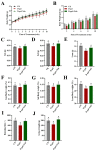Nobiletin Improves D-Galactose-Induced Aging Mice Skeletal Muscle Atrophy by Regulating Protein Homeostasis
- PMID: 37111020
- PMCID: PMC10146842
- DOI: 10.3390/nu15081801
Nobiletin Improves D-Galactose-Induced Aging Mice Skeletal Muscle Atrophy by Regulating Protein Homeostasis
Abstract
Sarcopenia, a decrease in skeletal muscle mass and function caused by aging, impairs mobility, raises the risk of fractures, diabetes, and other illnesses, and severely affects a senior's quality of life. Nobiletin (Nob), polymethoxyl flavonoid, has various biological effects, such as anti-diabetic, anti-atherogenic, anti-inflammatory, anti-oxidative, and anti-tumor properties. In this investigation, we hypothesized that Nob potentially regulates protein homeostasis to prevent and treat sarcopenia. To investigate whether Nob could block skeletal muscle atrophy and elucidate its underlying molecular mechanism, we used the D-galactose-induced (D-gal-induced) C57BL/6J mice for 10 weeks to establish a skeletal muscle atrophy model. The findings demonstrated that Nob increased body weight, hindlimb muscle mass, lean mass and improved the function of skeletal muscle in D-gal-induced aging mice. Nob improved myofiber sizes and increased skeletal muscle main proteins composition in D-gal-induced aging mice. Notably, Nob activated mTOR/Akt signaling to increase protein synthesis and inhibited FOXO3a-MAFbx/MuRF1 pathway and inflammatory cytokines, thereby reducing protein degradation in D-gal-induced aging mice. In conclusion, Nob attenuated D-gal-induced skeletal muscle atrophy. It is a promising candidate for preventing and treating age-associated atrophy of skeletal muscles.
Keywords: aging; nobiletin; protein homeostasis; sarcopenia.
Conflict of interest statement
There is no conflict of interest by the authors.
Figures






References
-
- Rafi S.T.M., Sambandam Y., Sittadjody S., Pathak S., Ramachandran I., Kumaran R.I. Chapter 9-Skeletal Muscle Cell Aging and Stem Cells. In: Pathak S., Banerjee A., editors. Stem Cells and Aging. Academic Press; Cambridge, MA, USA: 2021. pp. 125–145. - DOI
-
- Palla A.R., Ravichandran M., Wang Y.X., Alexandrova L., Yang A.V., Kraft P., Holbrook C.A., Schurch C.M., Ho A.T.V., Blau H.M. Inhibition of prostaglandin-degrading enzyme 15-PGDH rejuvenates aged muscle mass and strength. Science. 2021;371:eabc8059. doi: 10.1126/science.abc8059. - DOI - PMC - PubMed
-
- Tournadre A., Vial G., Capel F., Soubrier M., Boirie Y. Sarcopenia. Jt. Bone Spine. 2019;86:309–314. - PubMed
MeSH terms
Substances
Grants and funding
LinkOut - more resources
Full Text Sources
Research Materials
Miscellaneous

